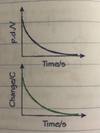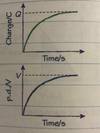Topic 8 Flashcards
(52 cards)
Equation: arc length
l = rθ
l = arc length
r = radius
θ = angle in radians
Equation: Time period of rotation *
T = 2π / ω
T = Time period of rotation (s)
ω = angular velocity (rad s-1)
Definition: Angular velocity
The angle swept out by an object with rotational motion in unit time.
(rad s⁻¹)
Definition: Time period of rotation
Time taken to complete one rotation.
Equation: Angular velocity
ω = Δθ / Δt
ω = angular velocity (rad s-1)
Δθ = angle turned through in radians
Δt = time taken (s)
What assumptions are made when using Δθ in rotational motion equations?
Δθ is in radians.
Equation: Tangential velocity *
v = ωr
v = tangential velocity (ms-1)
ω = angular velocity (rad s-1)
r = radius (m)
Definition: Centripetal acceleration
The acceleration produced by a centripetal force, causing an object to travel with circular motion.
Equation: Centripetal acceleration *
a = rω² = v²/ r
a = centripetal acceleration (ms-2)
r = radius (m)
ω = angular velocity (rad s-1)
v = tangential velocity (ms-1)
Equation: Centripetal force
F = mv² / r = mrω²
F = centripetal force (N)
r = radius (m)
ω = angular velocity (rad s-1)
v = tangential velocity (ms-1)
Definition: Centripetal force
The force providing an object with centripetal acceleration allowing it to have circular motion.
What is the feature of an object in circular motion?
It’s velocity is constantly changing meaning it accelerates centripetally due to a centripetal force.
What does rpm mean?
Rotations per minute.
Rpm / 60 = frequency
Why must there be a resultant force on an object which is changing direction?
It is changing direction so therefore velocity must also be changing. Therefore the object must be accelerating.
Definition: Electric field
A region in space where charged particles experience a force.
Definition: Electric field strength
The force per unit charge acting on a positive test charge at a point in space.
(NC⁻¹)
Equation: Electric field strength *
E = F / Q
E = electric field strength (NC-1)
F = force (N)
Q = charge (C)
What do the features of field lines represent?
Closeness = strength of field.
Direction = direction of force on positive charge.
What are the rules for drawing radial field lines?
- Cannot cross
- Start on positive
- End on negative
What are uniform fields?
A region of space where a force acts on a charged particle, and the force is constant at all points.
What are the rules for drawing uniform field lines?
- Parallel.
- Equally spaced.
Equation: Electric field strength between plates *
E = V / d
E = electric field strength (NC-1)
V = pd across plates (V)
d = distance between plates (m)
Definition: Electric potential
The work done per unit charge to move a small positive test charge from one point to another.
(JC⁻¹ = V)
Equation: Electric potential
V = EPE / Q
V = electric potential (JC -1 or V)
EPE = electric potential energy (J)
Q = charge (C)







